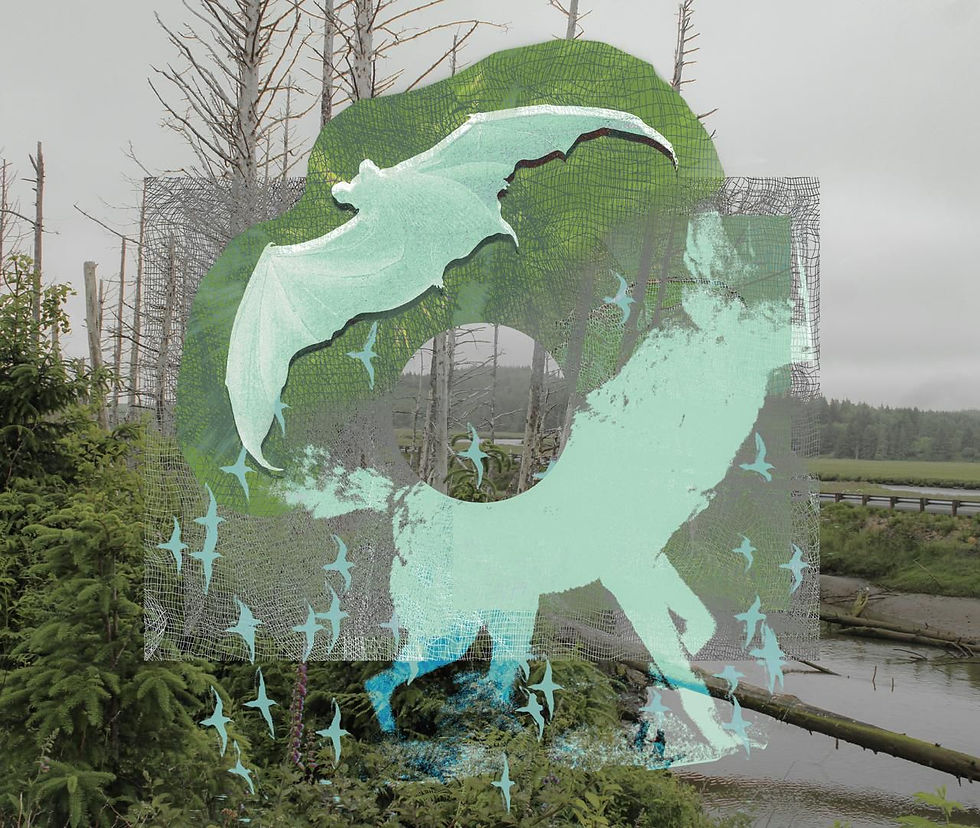In the Presence of Absence
- Daniel Gremme
- Apr 17, 2024
- 4 min read

In The Presence of Absence explores how the recontextualisation of quarries into nature reserves and hiking hotspots downplays human natural destruction. Grounded in research, the vertically stratified visual essay delves into the levels of exploitation involved, from territorial invasion to extraction and touristic activities, revealing hierarchies and the superior gaze of Western society.
The installation reflects on three protagonists involved in extraction. Samples of slate, a mineral heavily used in the beginnings of industrialization for roofing of factories, show their iridescent fossillised flowers from 300 million years ago. Industrial Big Bags, whose invention replaced wooden barrels for material transportation, maximised logistical capacity and therefore the volume of extraction. Finally, the human takes seat in them, enjoying the comfort they provide. Some even fell asleep. Only leftover or reuseable materials, have been used for the set up, except the 160x240cm canvas.
Film material has been recorded at the Piesberg and Dyckerhoff Quarries (DE) and a construction side in Münster (DE), negatives shown in the epilogue originate from the Dyckerhoff Lengerich Archive.

Shaped through millions of years, the ground yields our weight with infinite solidarity. Its fertile soil allows for roots to grow, graciously providing 95% of the nourishment we require to thrive. You, me, nonhumans — we all are deeply interwoven with the ground. It bears witness to all actions of its residents. As a permeable membrane between past and present, it internalised Earth's complex history layer by layer, down to the core. A mere centimetre of crafted topsoil passages 300 to 400 years. Driven by erosion, material artefacts downstream to the bottom of water bodies, percolate through sediments, and undergo cementation to solidify into rock.
Fossilised flowers portray mineral formation and the dignity of all materials. Miles under our feet they gleam in secret, too precious to be left uncovered. Convective currents in the Earth’s mantle orchestrate perpetual geological metamorphosis throughout expansive periods of time: roaring through centuries and continents, sublime over concepts of control or ownership.

12,000 years ago. Untamed rivers flowed wildly in volatile environments, next to nomadic humanoids. 5,000 years later the availability of water began to exhibit predictability and sea levels stabilised globally due to polar glacier melting. Civilisations of the surface were confronted with new routines, among them us, the humans. Rich soil and regulated flooding facilitated the emergence of agricultural practices alongside the rise of early civilisations. Human quarrying activities of limestone and flint begin, guided by systematic quality evaluation. As a first impulse of human metaphysical reconstruction, space is organized through the erection of architecture – opening up questions of the self and the world, interiority and exteriority, life and death. Continual occupation fosters exclusion: with our roofs, ideas of ownership arise, providing a perspective of territorial control. It is specifically the Western gaze that gradually turned from horizontal to vertical perspective, looking down on Earth and every one of its residents as a resource. Flat as a paved surface, aerial perspective keeps distance to the matter and reduces the physical world’s multifaceted nature to an imaginative model of reality. Vertical gaze replaces the colonial idea of endless horizons by abundantly available minerals below the surface. And the planet kept on spinning as before.

Announced by ascending clouds of mist, the Industrial Age begins.
Automation and mass production introduce a paradigm of unprecedented scale, shaped by its relentless hunger for resources. Western societies demand more and more of it, more than the skin of planet earth can provide. To comply with standards of living, the extraction of vital resources is externalised to specific regions, offering the desired abundance of resources. Scoop by scoop, Mines extend human presence vertically into the ground. Landscapes of absence emerge, as windows into the past. Former environments metamorphose into places shaped by profit—meticulously surveyed, possessed, utilised, and consequently, irreversibly altered. Rational calculation, abundant use of energy, and the precision of machines transform environmental violence into a wonder. Mines are also subject to criticism, but it is important to acknowledge that their flame is lit by our demands throughout decades. The global building floor is about to double by 2060, outpacing population growth by 50%. Our rising architectural edifices cast a shadow upon the hollow mountains left behind.

In far distance, the sources of our consumption fade away from immediate sight, becoming hidden within the fabric of our existence. Instead, they morph into silent spectacles. With 50-70% of altered ground worldwide, it is left to mines to present the pristine. Contextualised as recreation centers, violent marks of extraction become object to touristic gaze. Brought around its skin, sediment layers concealed for countless millennia are revealed, providing territory for alpine animals. Their excrement, sprinkles of irony. The planet wakes up, tickled by wheel loaders, blinded by the light. It falls asleep again, and keeps on spinning as before. Elevated hiking trails and viewing platforms offer tourists a superior, almost vertical perspective from above. The human spectator appears heroically larger in contrast to the massive scenery, which in its monotone miniature prevent emotional identification. Neither look the rolling machines to be harmful, the landscape to be detrimental, nor do those processes seem related to the room you are standing in. You are In The Presence of Absence.

Daniel Gremme is a Hague-based designer and filmmaker.




Having browsed basswinscasino.uk, I can conclude that it is a legitimate site for online gaming. The site has a good collection of games and allows multiple payment options. Bear in mind that it is also licenced by government, like many other sites, so it does not offer the same level of protection for players as a site licenced by the UKGC.